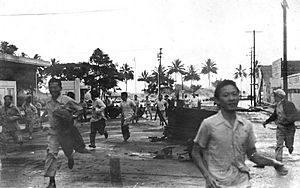Hilo Bay facts for kids
Hilo Bay is a large bay located on the eastern coast of the island of Hawaiʻi. It's a beautiful and important natural harbor. The modern town of Hilo, Hawaii sits right next to Hilo Bay.
What is Hilo Bay Like?
Hilo Bay is surrounded by amazing natural features. To the north, you'll find the Hamakua Coast on the slopes of Mauna Kea, a huge volcano. To the south, there's the Puna district on the slopes of Mauna Loa, another giant volcano.
The land just behind the bay is called the Hilo district. It's part of the County of Hawaii. You can also find Banyan Drive here, which goes through the lovely Liliʻuokalani Gardens right by the bay.
A Look Back at Hilo Bay's History
Long ago, the Hawaiian name for the village near the bay was Waiākea. In 1825, a ship called HMS Blonde explored the bay. Its captain, George Byron, 7th Baron Byron, gave the bay the name Byron's Bay. There's even a coral reef on the eastern side of the bay called Blonde Reef, named after the ship.
A special wall called a breakwater was built across the bay. It helps protect the harbor from big waves. Construction started in 1908 and was finished in 1929. There's also a small island in the bay called Moku Ola, which means "island of life." Long ago, it was a sacred place with a temple for healing.
Hilo Bay and Tsunamis
Hilo Bay is sometimes called "the tsunami capital of the United States." This is because the shape of the bay can direct tsunamis (giant ocean waves) right towards Hilo. These powerful waves often come from earthquakes in places like Chile and the Aleutian Islands.
One very sad event happened on April 1, 1946. A tsunami from an earthquake in the Aleutian Islands hit Hilo Bay, and 96 people lost their lives. Another huge tsunami struck on May 23, 1960. This one came from the 1960 Valdivia earthquake in Chile, which was the strongest earthquake ever recorded. It caused 61 deaths in Hilo.
However, things have improved a lot! After an earthquake in Chile on February 27, 2010, the Pacific Tsunami Warning Center (PTWC) showed how helpful it is. Their sirens sounded, and people were told to evacuate. Because of these warnings, no one was hurt in Hilo Bay during that tsunami.



